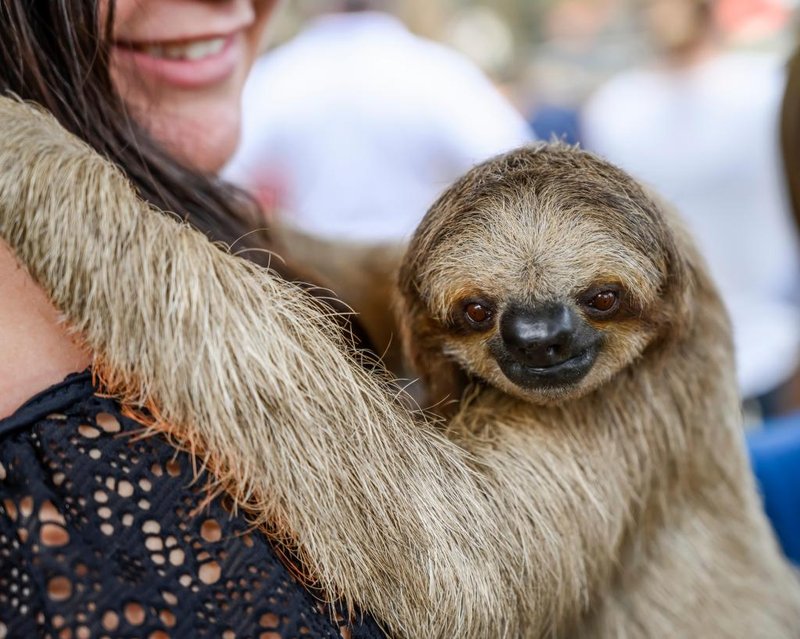
Imagine a slow-moving, gentle being that has evolved to glide through life at a snail’s pace. It wouldn’t seem likely that such a creature could be anything but benign. However, as with many animals, there’s often more than meets the eye. Let’s dive into what makes sloths unique, how they interact with their environment, and whether or not they can be dangerous to humans.
The Nature of Sloths
Sloths are fascinating creatures native to Central and South America. They belong to the order Pilosa and are known for their slow metabolism and even slower movements. Most sloths spend their lives hanging upside down in trees. Their diet mainly consists of leaves, which are tough to digest. The unique way sloths move and eat plays a big role in their lifestyle.
What sets sloths apart from other animals is their distinct lack of speed. They can only move about 0.03 miles per hour. This leisurely pace means they rely heavily on camouflage for protection against predators like jaguars and eagles. Their fur even hosts algae, which helps them blend into the trees. It’s like wearing a natural disguise!
Despite their slow nature, these creatures possess strong, curved claws that enable them to grip branches securely. While this helps them navigate through the treetops, those claws can also inflict injuries if a sloth feels threatened.
Can Sloths Bite?
You might be wondering if sloths have the ability to bite humans. The answer is yes, they can, but it’s rare. Sloths don’t typically see humans as threats, but they will defend themselves if provoked. Their bites can be surprisingly powerful, thanks to strong jaws.
If a sloth does feel cornered, it may react by biting. Unlike typical pets, sloths do not bite out of aggression; it’s more a reflex to protect themselves. So, if you come across a sloth in the wild, it’s wise to admire from a distance.
For example, a wildlife photographer once shared an experience where they tried to get a close-up shot of a sloth. Instead of posing for the camera, the sloth felt threatened and bit the photographer’s camera strap, leaving a noticeable mark. This illustrates the need for respect when interacting with wildlife.
Are Sloths Carriers of Disease?
Now, let’s touch on another aspect: health risks. Like many animals, sloths can carry parasites and diseases. While they’re not known for spreading illness to humans, it’s possible. Their fur can harbor certain types of bacteria and fungi that might pose health risks if touched.
In addition, sloths sometimes carry parasites, such as ticks, which can lead to diseases like Lyme disease. It’s a reminder that any wild animal can potentially carry health risks, so caution should always be practiced. Even if sloths seem adorable, it’s important to remember they are still wild animals and should be treated as such.
If you’re planning to encounter sloths, whether in the wild or at a sanctuary, ensure you wash your hands afterward and avoid direct contact whenever possible.
The Sloth’s Defense Mechanisms
Sloths have a few clever ways to avoid danger, and their lethargic demeanor plays a big role. Their slow moves and tree-dwelling lifestyle help them remain undetected from predators. When threatened, they often remain still, hoping their camouflage will keep them safe.
Another defense mechanism is their sharp claws. While they don’t use them aggressively, if a sloth feels threatened, they can swipe or bite as a means of self-defense. It’s not something they do lightly, but it’s a reminder that even the most laid-back creatures have their limits.
In the wild, sloths are generally not known to confront larger animals, preferring to stay out of sight. This means that while they can defend themselves, they’d rather avoid any type of confrontation altogether.
Interactions with Humans
You might be curious about how sloths interact with humans, especially in places like wildlife reserves or animal sanctuaries. Often, these environments focus on education and conservation, allowing people to appreciate sloths without overwhelming them.
In some cases, sloths are even kept as pets, though this practice is discouraged by wildlife experts. They have specialized needs and require a specific diet that can be difficult to provide outside their natural habitat. Plus, sloths are not domesticated animals, and keeping one can lead to stress for the animal.
If you’re lucky enough to see a sloth in a sanctuary, it’s usually under the supervision of professionals who understand their behavior. They ensure that the sloths are comfortable and safe, allowing visitors a glimpse into their unique world without causing harm.
Final Thoughts on the Sloth’s Danger to Humans
So, can sloths be dangerous to humans? Overall, sloths are not aggressive creatures and prefer to live peacefully among the trees. However, like all wild animals, they can bite or carry diseases if provoked or mishandled. It’s crucial to respect their space and appreciate them from a distance.
While they present minimal danger, understanding their behavior helps promote safe interactions. Sloths might be slow and sleepy, but they are still wild animals deserving of respect. The best way to enjoy their charm is to observe without interference, allowing these delightful beings to thrive in their natural habitat.
In summary, while sloths are generally safe to be around, it’s always best to approach them with caution and admiration. Treat them with the respect they deserve, and you’ll enjoy what makes them truly special without putting yourself or the sloth at risk.

